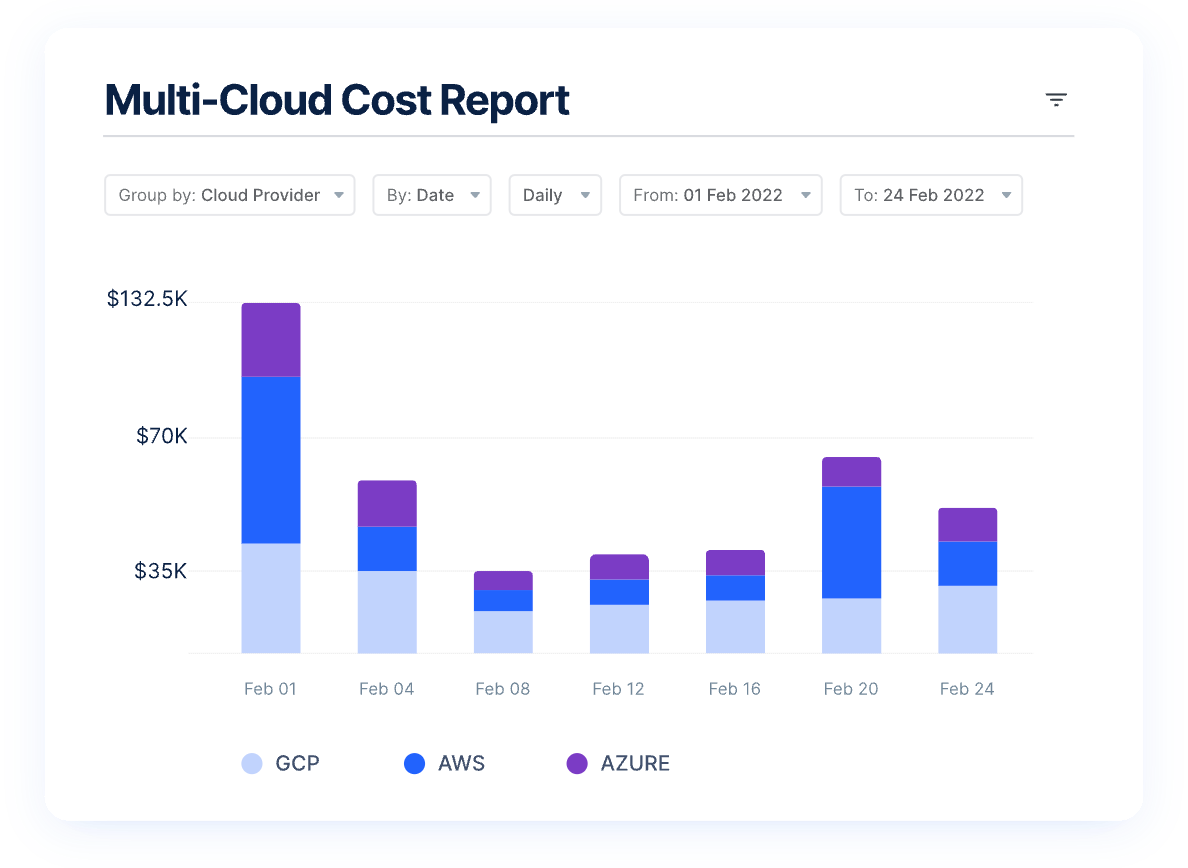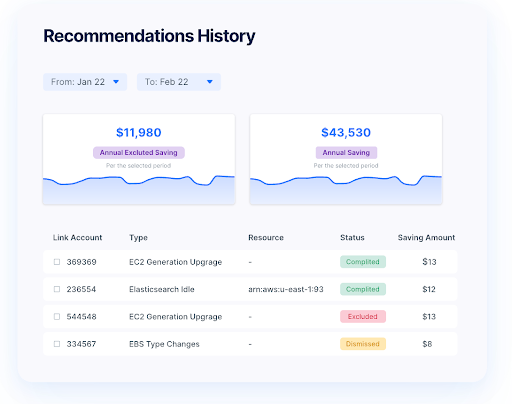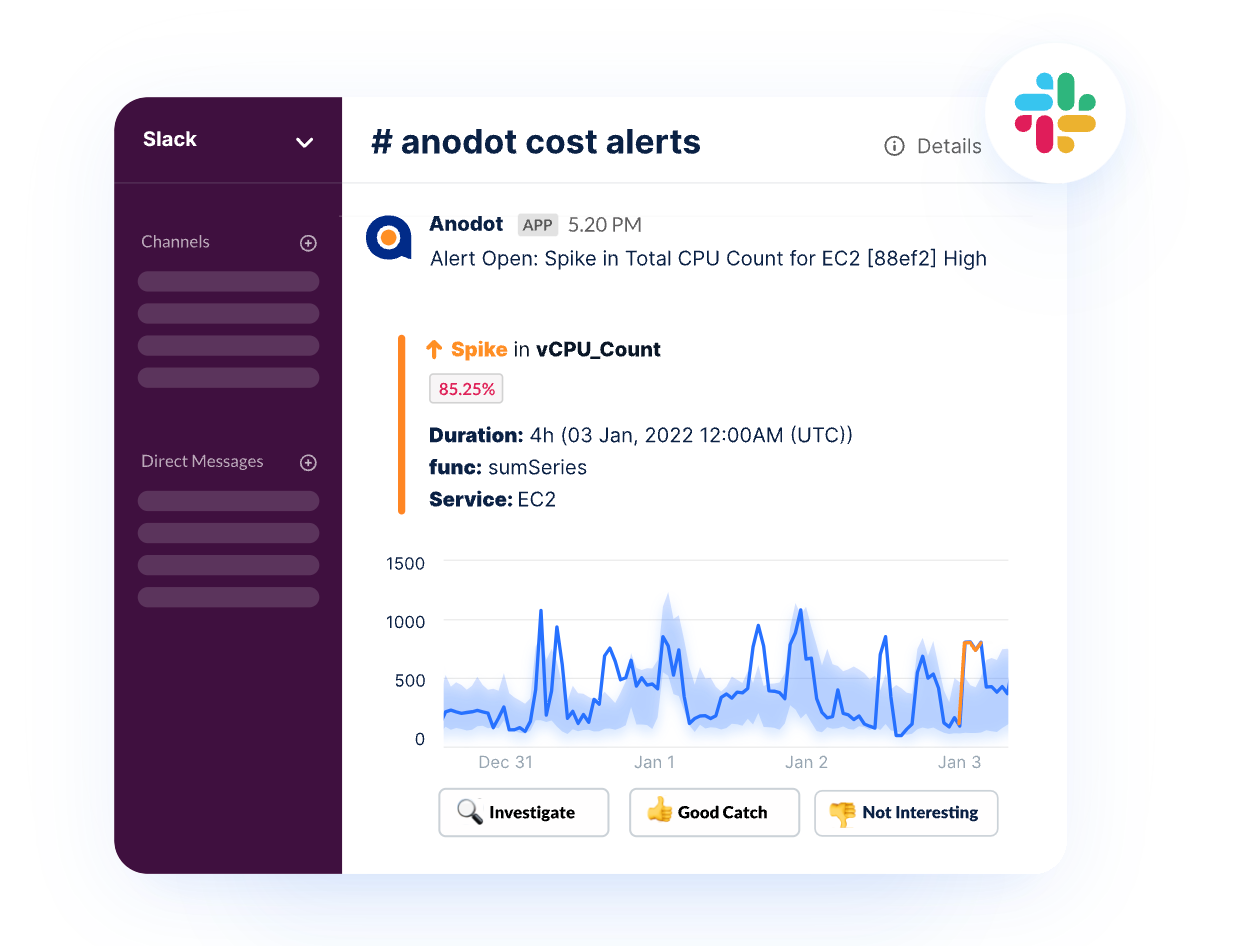What Is Cloud Optimization?
Cloud optimization refers to the process of adjusting your cloud environment and resources to improve efficiency, performance, and cost-effectiveness. It involves analyzing current usage, identifying inefficiencies, and making changes to resource allocation, configurations, and services to better match your needs. This process helps organizations make the most out of their cloud investment by ensuring resources are used most effectively.
The goal of cloud optimization is not only to reduce costs but also to enhance the performance and scalability of applications running in the cloud. By continuously monitoring and optimizing the cloud environment, businesses can respond more quickly to changing demands, avoid over-provisioning, and ensure that their applications are running smoothly and efficiently.
Below is an example of cloud optimization. This dashboard provides recommendations for upgrading, stopping, or right-sizing cloud resources to optimize cost.

Learn more about the cloud cost management platform from Anodot, which provides cost optimization recommendations and much more.
This is part of a series of articles about cloud management.
In this article:
- Why Is Cloud Optimization Important?
- What Should You Optimize in Your Cloud Environment?
- Types of Cloud Optimization Services and Tools
- Best Practices to Optimize Your Cloud Environment
Why Is Cloud Optimization Important?
Cloud optimization is crucial because it directly impacts an organization’s bottom line and operational efficiency. Without proper optimization, companies can end up paying for unused or underutilized resources, leading to unnecessary expenses. According to the HashiCorp State of Cloud Strategy Survey, over 90% of companies believe they are spending too much on the cloud.
According to Gartner, public cloud spending was almost $600 billion in 2023, showing how large the problem is. Optimizing the cloud environment ensures that resources are allocated according to actual needs, reducing waste and lowering costs.
Optimization also plays a key role in maintaining high performance and availability of cloud-based applications. By ensuring that resources are appropriately scaled and configured, businesses can improve user experience, meet SLAs, and support business growth without facing performance bottlenecks or downtime.
What Should You Optimize in Your Cloud Environment?
Cost-Effectiveness
Optimizing for cost-effectiveness involves identifying and eliminating waste in your cloud spending. This means turning off idle resources, choosing the right size and type of resources for your workload, and taking advantage of discounts offered by cloud providers for commitments or reserved instances. Effective cost management ensures you’re only paying for what you actually need and use.
Furthermore, by analyzing usage patterns and adopting a pay-as-you-go model, organizations can significantly reduce costs. Implementing policies for budget management and cost allocation helps in keeping track of spending and making informed decisions about resource utilization.
Performance
Performance optimization focuses on ensuring that your applications run efficiently and respond quickly to user demands. This involves selecting the right types of resources for your workloads, configuring your environment to maximize resource utilization, and scaling resources dynamically based on demand. By optimizing for performance, you can improve user satisfaction and engagement with your applications.
Additionally, implementing caching, using content delivery networks (CDNs), and optimizing databases are crucial strategies. These adjustments help in reducing latency, improving load times, and ensuring that your applications can handle high traffic volumes without degradation in performance.
Reliability
Reliability optimization is about ensuring that your cloud environment is resilient and can handle failures gracefully. This includes designing for fault tolerance, implementing backup and recovery strategies, and ensuring data integrity. By optimizing for reliability, businesses can guarantee high availability and minimize downtime.
Strategies such as geographical distribution of resources, replication, automatic failover mechanisms, and regular testing of recovery procedures are essential. These measures help in quickly recovering from incidents without significant impact on business operations.
Security
Security optimization in the cloud involves strengthening your environment against vulnerabilities and threats. This means implementing robust access controls, encrypting data at rest and in transit, and regularly monitoring and auditing the environment for suspicious activities. Optimizing security helps in protecting sensitive data and ensuring compliance with regulatory standards.
Adopting a security-first mindset and leveraging automated security tools can significantly reduce the risk of breaches. Continuous vulnerability assessments and integrating security into the development lifecycle are also crucial components of a strong cloud security posture.
Types of Cloud Optimization Services and Tools
1. Multicloud Cost Management Tools
Multicloud cost management tools provide visibility and control over spending across multiple cloud platforms. These tools aggregate cost data, provide comprehensive analytics, and recommend cost-saving measures.
By using multicloud cost management tools, organizations can identify unnecessary expenditures, optimize resource allocations, and take advantage of the best pricing options available across different cloud providers. This holistic approach to cost management is crucial for businesses leveraging services from more than one cloud vendor, ensuring that their cloud strategy is both cost-effective and efficient.

2. Kubernetes Cost Optimization
Kubernetes cost optimization focuses on managing and reducing the costs associated with running containers in Kubernetes environments. Tools and strategies for Kubernetes cost optimization include rightsizing container resources, implementing efficient cluster autoscaling, and using spot instances for non-critical workloads.
By monitoring and optimizing the use of Kubernetes resources, organizations can significantly reduce the overheads associated with container orchestration, ensuring that their containerized applications run efficiently without overspending on infrastructure.

3. Performance Optimization Tools
Performance optimization tools focus on monitoring and improving the speed and responsiveness of applications in the cloud. These tools analyze application performance, identify bottlenecks, and provide recommendations for enhancements. By utilizing performance optimization tools, organizations can ensure their applications meet user expectations and perform efficiently under varying load conditions.
These tools also help in capacity planning, enabling businesses to scale resources up or down based on real-time demand. This dynamic approach to resource management ensures optimal performance while avoiding unnecessary costs.
4. Storage Optimization Services
Storage optimization services are designed to help organizations manage their data storage needs more efficiently. These services offer features like data deduplication, compression, and tiering, which can significantly reduce storage costs and improve access speeds. By optimizing storage, businesses can ensure that data is stored in the most cost-effective manner without compromising on accessibility or security.
Moreover, storage optimization services facilitate better data management practices, such as archiving old data to cheaper storage options and automatically moving frequently accessed data to higher-performance storage. This not only reduces costs but also improves data access performance.
5. Cloud Security Solutions
Cloud security solutions focus on protecting cloud environments from internal and external threats. These solutions offer a range of features including identity and access management, threat detection, data encryption, and security compliance.
By deploying cloud security tools, organizations can strengthen their defense against cyberattacks, prevent unauthorized access to sensitive information, and ensure their cloud deployments comply with industry regulations and standards. Additionally, these tools can automate security processes, making it easier to manage security at scale.
Best Practices to Optimize Your Cloud Environment
1. Right Sizing Cloud Resources
Right sizing involves adjusting the size and capacity of cloud resources to match the demand closely. Many organizations overprovision resources to avoid performance issues, leading to unnecessary costs. Rightsizing ensures that each resource is the appropriate size for its workload, maximizing cost-efficiency without compromising performance.
This process should be continuous, as workloads and application demands can change over time. It is important to routinely review and adjust resources, maintaining an optimal balance between performance and cost.
2. Address Anomalies
Identifying and addressing anomalies in cloud usage is vital for maintaining an optimized environment. Anomalies, such as sudden spikes in resource usage or unexplained increases in costs, can indicate inefficiencies or misconfigurations. Monitoring tools and services can help detect these irregularities early, allowing for prompt investigation and resolution.
By proactively addressing anomalies, organizations can avoid potential performance issues and reduce wasteful spending. This process involves regular audits of cloud resources and usage patterns, ensuring that resources are being utilized most effectively.

3. Making Use of Spot and Reserved Instances
Leveraging spot and reserved instances can significantly reduce cloud computing costs. Spot instances allow users to bid for unused cloud capacity at lower prices, ideal for flexible, non-critical workloads. Reserved instances offer discounted rates in exchange for a commitment to use a specific amount of resources over a predetermined period.
Both options require careful planning and management to maximize savings while meeting workload requirements. Understanding your application’s tolerance for interruptions and its long-term resource needs is key to making the most of these pricing models.
4. Use Automated Tools to Streamline and Automate Optimization Tasks
Automated tools play a critical role in optimizing cloud environments. They can automate routine tasks such as resource provisioning, scaling, and monitoring, reducing the need for manual intervention and minimizing the risk of human error. This not only saves time but also ensures a more consistent and efficient operation of cloud resources.
Advanced cost optimization tools can also help in implementing cost-saving measures, such as shutting down idle resources, scaling services based on demand, and applying spot or reserved instances for relevant workloads. By integrating these tools into your cloud strategy, you can save time and generate more significant cost savings and performance improvements.
5. Using Managed Service Providers (MSPs) for Cost Optimization
Managed service providers (MSPs) offer a way to further optimize cloud environments. These services can include database management, application monitoring, and security. By leveraging the expertise of managed service providers, organizations can improve efficiency, enhance security, and reduce the burden on internal teams.
Additionally, managed services can help optimize costs by providing access to advanced tools and resources without the need for significant upfront investment. This allows organizations to benefit from high-quality services while focusing their efforts on core business functions.
6. Utilizing AI for Cost Optimization
AI is becoming increasingly important for cloud cost optimization. These tools can analyze vast amounts of data to identify patterns, predict future usage trends, and recommend actions to reduce costs. For instance, AI can suggest the best times to purchase reserved instances or identify underutilized resources that can be downsized.
By leveraging AI for cloud optimization, organizations can take a proactive approach to managing their cloud expenses. These tools provide valuable insights that can lead to more informed decision-making and ultimately, a more cost-efficient cloud environment.
Cloud Optimization with Anodot
Anodot can significantly aid companies in cloud management in the following ways:
1. Real-time Anomaly Detection: Anodot’s platform swiftly identifies unusual cloud cost spikes, enabling proactive cost management and prevention of overruns.
2. Automated Insights: Leveraging AI, it provides actionable insights for efficient cloud resource utilization and cost reduction strategies.
3. Multi-cloud Support: Anodot is adept at handling environments spanning multiple cloud platforms, offering unified visibility and control.
4. Customizable Alerts: Tailored alerting systems keep teams informed of critical changes or issues in cloud usage and expenditure.
5. Advanced Forecasting: The platform offers predictive analysis for future cloud spending, aiding in better budgeting and financial planning.
These capabilities make Anodot a valuable tool for companies looking to optimize their cloud infrastructure and finances effectively.




